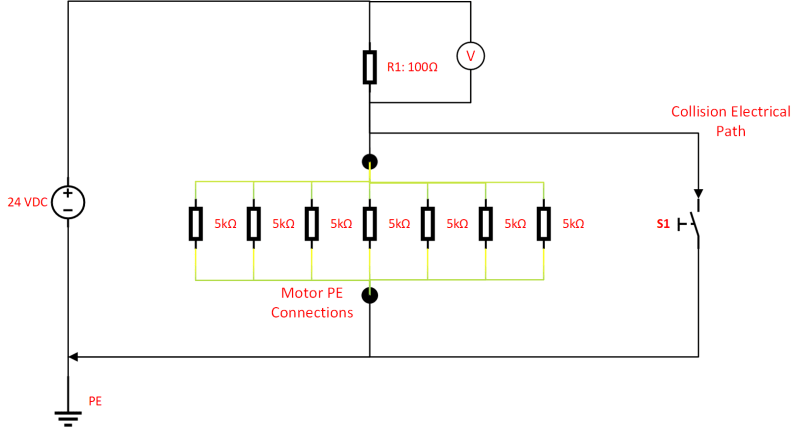dmac123
Aerospace
- Sep 24, 2023
- 5
Dear Eng-Tips Community,
We require a collision detection system for our robot with the plan to electrically isolate the rig from the adjacent structures and putting it at 24 VDC with a 100ohm resistor. Then when the rig contacts any of the adjacent structures the voltage will change as the overall resistance of the circuit changes with the additional path to earth. What we did not account for is that all the motors (7 in total) are earthed to the servo drives. The only thing I can think to do to mitigate this is to put resistors on the PE lines for all the motors to increase their resistance - see posted circuit diagram. Then if the rig contacts one of the earthed, adjacent structures the resistance of the overall circuit will change causing a step change in the voltmeter reading which I can then read with our DAQ. Let me know if you think this will work. I'm a bit weary about increasing the resistance of the PE lines from the motors which are used for motor's earth leakage current.
Thanks for your assistance.

We require a collision detection system for our robot with the plan to electrically isolate the rig from the adjacent structures and putting it at 24 VDC with a 100ohm resistor. Then when the rig contacts any of the adjacent structures the voltage will change as the overall resistance of the circuit changes with the additional path to earth. What we did not account for is that all the motors (7 in total) are earthed to the servo drives. The only thing I can think to do to mitigate this is to put resistors on the PE lines for all the motors to increase their resistance - see posted circuit diagram. Then if the rig contacts one of the earthed, adjacent structures the resistance of the overall circuit will change causing a step change in the voltmeter reading which I can then read with our DAQ. Let me know if you think this will work. I'm a bit weary about increasing the resistance of the PE lines from the motors which are used for motor's earth leakage current.
Thanks for your assistance.

